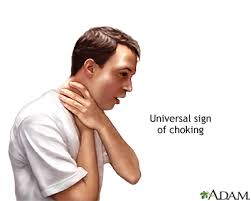
Choking happens when something blocks a person's airway, making it hard or impossible to breathe. Recognizing the signs quickly can help you act fast and save a life.
One of the most common signs of choking is inability to speak or cry. If someone tries to talk but no sound comes out, they may be choking. Coughing weakly or making high-pitched noises are also warning signs that air is not getting through properly.
Often, a person who is choking will grab at their throat — this is called the universal sign of choking. They may also panic, look very scared, and turn red or even blue around the lips and face as their oxygen level drops.
Other signs include difficulty breathing, wheezing, or gasping for air. If the blockage isn’t cleared quickly, the person may become unconscious.
In babies and small children, choking can look a little different. They might have trouble crying, make soft sounds, cough weakly, or appear to be gagging without making noise. Their skin may also turn pale or blue very quickly.
If you think someone is choking, it's important to act immediately. Encourage them to cough forcefully if they can. If they can’t breathe, cough, or talk, perform the Heimlich maneuver (abdominal thrusts) or call emergency services right away.
Choking is scary, but knowing the signs can help you stay calm and take quick action. Learning basic first aid skills, like how to help someone who is choking, is a great way to be prepared in case of an emergency.





 click and follow Indiaherald WhatsApp channel
click and follow Indiaherald WhatsApp channel